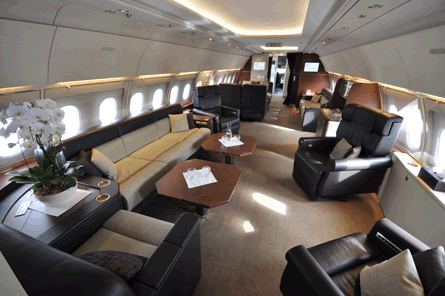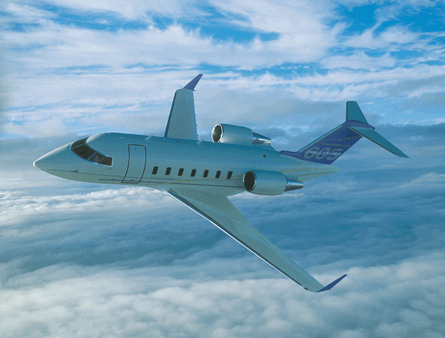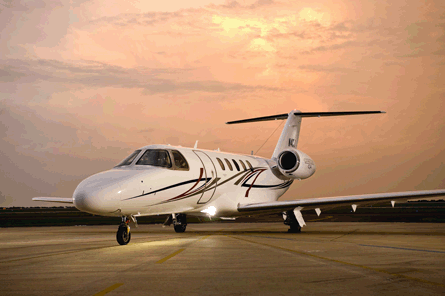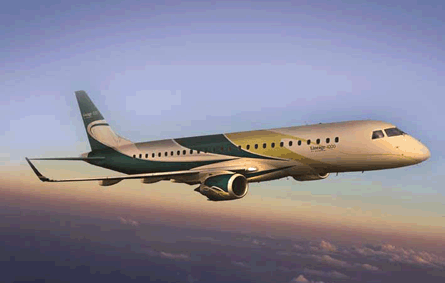Flight International canvassed the major business aircraft manufacturers or their local representatives for their views on prospects for the Middle East market
AIRBUS
Francois Chazelle, Airbus vice-president executive and private aviation
The Middle East accounts for around half of all Airbus VIP single- and twin-aisle types flying. Of the 16 aircraft we expect to deliver this year, half will go to the Middle East, to governments, royalty, large corporations and wealthy individuals.
The A340 is the most popular widebody and the Airbus Corporate Jetliner and A320 Prestige the most popular narrowbodies. The first VIP A380 was sold to a Middle Eastern customer; the green aircraft is to be delivered next year. The Middle East will account for the lion's share of the predicted 25-30 VIP A380 sales over the next 10 years.
 |
|---|
© ComluxAirbus VIP types are popular |
We expect demand to come from Boeing 747 customers seeking more space. In the Middle East, where traditionally women and men are separated [during flights], the A380's 550m2 (5,920ft2) of floorspace - 30% more than the 747 - and two complete decks will be popular. The "wait and see" attitude from customers over the past two years has started to fade and we are seeing positive signs that the market is returning.
BOEING BUSINESS JETS
Robert Johnstone, BBJ sales Middle East
The Middle East is one of our biggest markets, with a high concentration of twin- and single-aisle VIP-configured aircraft. Around 40% of this fleet is based in Saudi Arabia and the UAE. Boeing has around a 60% share of the twin-aisle market, with the 747, 767, 777 and MD-11.
The 747-8 is popular, with seven sold into the Gulf region. The same numbers of 787-8s have been sold to Middle Eastern customers and demand is outweighing supply, with the next available delivery slot not until 2019. Boeing has around 48% of the single-aisle market, dominated by the BBJ family, the 737, 727 and the MD-80.
The typical VIP twin-aisle customer in the Middle East is better insulated against economic downturns. They are not sensitive to market perceptions and their purchase decisions are made differently to other traditional business jet transactions.
BOMBARDIER BUSINESS AIRCRAFT
Khader Mattar, regional vice-president sales Europe, Middle East and Africa
The economic crisis has hit every corner of the world, but the Middle East has remained strong and ranks as one of our largest international markets. The Challenger 600 series 850 and Global Express XRS are our best sellers in the region, where demand for large-cabin aircraft is strong.
 |
|---|
© BombardierChallenger is a best-seller |
Therefore, we expect the new Global 7000 and 8000 ultra-long-range types to be popular in the Middle East. Nonetheless, the Learjet family has found a niche, particularly in the past six years because of the expansion of the business community and a growth in the number of entrepreneurs who are using light-cabin aircraft as business tools to travel around the region. Learjet types are becoming popular with charter companies.
CESSNA
Trevor Esling, vice-president international sales
Cessna has been active in the Middle East for years and the region has become increasingly important to us over the past decade.
Although other international markets have the potential to deliver higher sales volumes in the long term, Cessna has been making steady progress in growing the Middle East's Citation fleet, particularly with auxiliary power unit-equipped Citation Sovereign and XLS-series aircraft.
The region holds sales promise for midsize aircraft, as more customers seek the advantages of business aviation without the expense of purchasing large-cabin aircraft. Of our lighter aircraft, we feel the CJ3 and CJ4 have strong sales potential because of their potential for regional transport.
The Citation brand has a strong following in the region. Our typical customers own private businesses and require a cost-effective solution for flying within the Middle East and into western Europe.
 |
|---|
© CessnaCitations offer long range |
Like Russia, the Middle East market has developed in a "top-down" manner, with large-cabin aircraft doing well from the outset, but demand for midsize and light aircraft is increasing as the market has matured. The ability to fly non-stop from Riyadh to London is a consideration for some, so Cessna's ability to offer this capability with a winglet-equipped Citation X and the forthcoming Citation Ten is helpful.
DASSAULT
Vadim Feldzer, corporate communications manager
While Western economies are still struggling on the way to recovery, the level of consumer confidence seems to be returning to the Middle East and we saw more demand there in the past two quarters.
Our sales have been busy over the past six months and flying hours are on the increase for operators. We will have 60 aircraft in the region by the end of the year, increasing to 80 within two to three years.
High-end positioning of the Falcon line - notably the 7X, 900EX/LX and 2000EX/LX - with technologies such as the EASy flightdeck and digital flight control systems has helped to drive sales.
EMBRAER
Colin Steven, vice-president marketing and sales
The Middle East is a very important for us. Embraer is a relative newcomer to the business aviation market and sales of our airliners to regional carriers such as Gulf Air, Oman Air, Egypt Air and NasAir has boosted the Embraer brand and helped to notch up sales of the Embraer 190-based Lineage 1000 and ERJ-135-based Legacy.
Our largest fleet customer, Al Jaber, will take delivery shortly of its sixth Lineage. The company also operates two Legacy 600s. The Middle East was one of the key drivers behind our decision to launch the large-cabin Legacy 650. It has the 600's three-zone cabin and huge baggage area - a must in the Middle East - but a much greater range, allowing it to fly from Dubai to London with seven passengers.
 |
|---|
© EmbraerSales success: Lineage 1000 |
The Middle East has traditionally swung towards large-cabin aircraft. The culture has changed in recent years and people are turning to smaller types such as the Phenom 300 that they can operate regionally without the heftier costs of a larger-cabin aircraft. We are also making strides with the Legacy 500 and 450, which will enter service in 2012 and 2013.
GULFSTREAM
Larry Flynn, senior vice-president marketing and sales
The Middle East is one of Gulfstream's key markets and we dominate the large-cabin sector with an installed base of 100 aircraft. We have doubled our fleet since 2001, with most aircraft going to private companies, wealthy individuals and heads of state. Even through the economic downturn sales to the Middle East of our large-cabin types - the G450, G550 and G650 - held up as many buyers in the region have weathered the financial storm.
 |
|---|
© GulfstreamLarge-cabin sales are steady |
Midsize aircraft - the G150 and G200/250 market - have fared less well.
HAWKER BEECHCRAFT
Sean McGeough, president EMEA
The Middle East has traditionally been a market for large business jets, but the dynamic has changed over the past five years. New entrants into this sector cannot afford to buy or operate bigger aircraft so our product line - especially the King Air twin turboprop family and Hawker 400XP light-cabin business jet - have gained in popularity. We have four 400XPs, eight 750XPs and a number of Hawker 4000s the region and the level of interest is on the increase,
The King Air market is particularly strong.
PIAGGIO
Karim Hijazi, managing director Air Synapsis, Piaggio's representative for Jordan, Lebanon and the Gulf
The Middle East has traditionally been a market for large-cabin business jets, but opportunities are opening for us, particularly within the local business community for which the P180 Avanti II seems to be the right aircraft with the right platform at the right time.
There are a growing number of educated business people who are attracted to the turboprop because it is cheaper to operate than equivalent-sized jets. They also believe that efficiency is more important than luxury.
 |
|---|
© PiaggioTurboprops: educated choice |
Nonetheless, the rate of spontaneous contacts from private owners is on the increase and from operators who seek an aircraft for charter, air ambulance and medevac missions.
We operate five aircraft in the Middle East - two in the UAE, two in Jordan and one in Kuwait, but most business traffic is concentrated within the Gulf Cooperation Council countries.
Source: Flight International
















